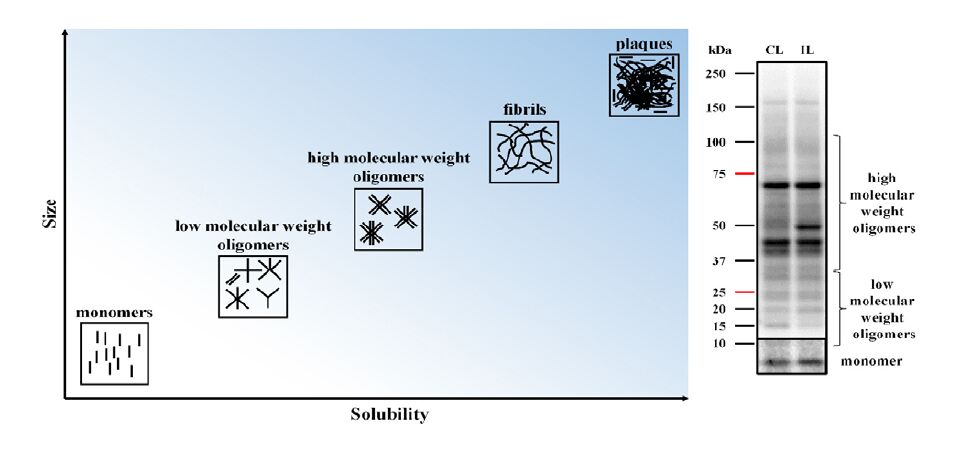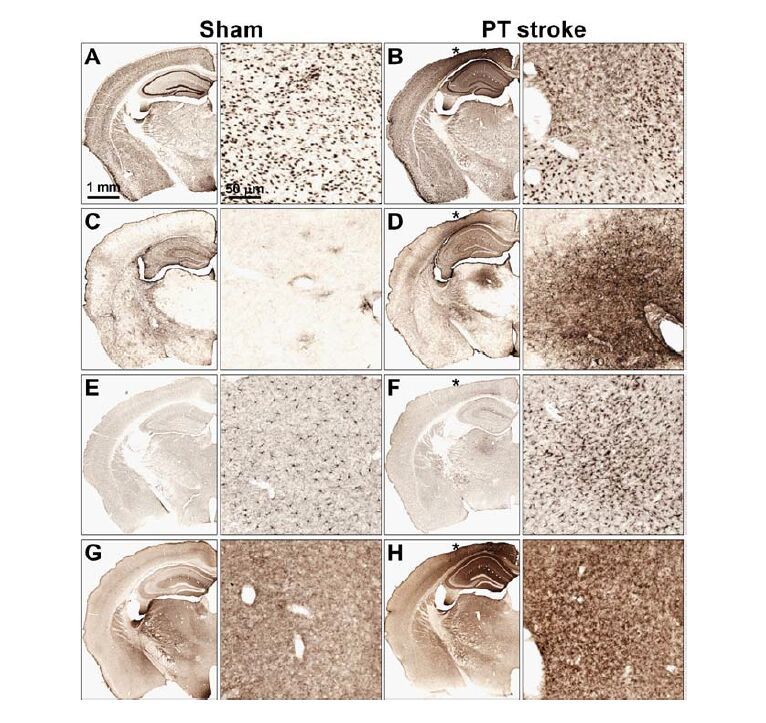Stroke-induced secondary neurodegeneration (SND) refers to the progressive and inexorable loss of tissues at sites connected to area damaged by the initial infarction. SND has been consistently observed to occur in humans and rodents after stroke. Intriguingly, stroke-induced SND shares a number of striking similarities to other neurodegenerative diseases such as Alzheimer’s disease, most notably with respect to the significant accumulation of the neurotoxic protein amyloid-β. Together, this observation and others (progressive neuronal loss and neuroinflammation) suggest the possibility that stroke may induce a neurodegenerative condition. Certainly, this is supported to some degree by the relatively high incidence of dementia after stroke. We begin this review by addressing the available research on human and rodent SND pathology after stroke. We next consider amyloid-β in the context of SND. We discuss what amyloid-β is, how is it made, and introduce some caveats on how amyloid-β measurements should be interpreted. In summary, we conclude that there is now robust pre-clinical evidence demonstrating the presence of amyloid disturbances at sites of SND after stroke. We find, however, that the human literature on the topic is more limited and further work is warranted. While the understanding of amyloid disturbances remains inconclusive in human studies, stroke clearly lead to the development of a neurodegenerative-like condition at the sites of SND, with prominent features such as death of neurons and gliosis.
1.
Introduction
Several years ago, Bensoussan, Sethi, Vickson and Derzko [1] have been considered the case of a factory producing one type of economic goods and observed that it is necessary to solve the simple partial differential equation
where σ∈(0,∞) denotes the diffusion coefficient, α∈[0,∞) represents psychological rate of time discount, x∈RN is the product vector, z:=zαs(x) denotes the value function and |x|2 is the loss function.
Regime switching refers to the situation when the characteristics of the state process are affected by several regimes (e.g., in finance bull and bear market with higher volatility in the bear market).
It is important to point out that, when dealing with regime switching, we can describe a wide variety of phenomena using partial differential equations. In [1], the authors Cadenillas, Lakner and Pinedo [2] adapted the model problem in [1] to study the optimal production management characterized by the two-state regime switching with limited/unlimited information and corresponding to the system
where σ1,σ2∈(0,∞) denote the diffusion coefficients, α1,α2∈[0,∞) represent the psychological rates of time discount from what place the exponential discounting, x∈RN is the product vector, usr:=usr(x) (r=1,2) denotes the value functions, |x|2 is the loss function, ρ∈[−1,1] is the correlation coefficient and anm (n,m=1,2) are the elements of the Markov chain's rate matrix, denoted by G=[ϑnm]2×2 with
the diagonal elements ϑnn may be expressed as ϑnn=−Σm≠nϑnm.
Furthermore, in civil engineering, Dong, Malikopoulos, Djouadi and Kuruganti [3] applied the model described in [2] to the study of the optimal stochastic control problem for home energy systems with solar and energy storage devices; the two regimes switching are the peak and the peak energy demands.
After that, there have been numerous applications of regime switching in many important problems in economics and other fields, see the works of: Capponi and Figueroa-López [4], Elliott and Hamada [5], Gharbi and Kenne [6], Yao, Zhang and Zhou [7] and Wang, Chang and Fang [8] for more details. Other different research studies that explain the importance of regime switching in the real world are [9,10].
In this paper, we focus on the following parabolic partial differential equation and system, corresponding to (1.1)
and (1.2) respectively
where zαs is the solution of (1.1) and (us1(x),us2(x)) is the solution of (1.2). The existence and the uniqueness for the case of (1.1) is proved by [10] and the existence for the system case of (1.2) by [11].
From the mathematical point of view the problem (1.3) has been extensively studied when the space RN is replaced by a bounded domain and when α=0. In particular, some great results can be found in the old papers of Barles, Porretta [12] and Tchamba [13]. More recently, but again for the case of a bounded domain, α=0 and in the absence of the gradient term, the problem (1.3) has been also discussed by Alves and Boudjeriou [14]. The interest of these authors [12,13,14] is to give an asymptotic stable solution at infinity for the considered equation, i.e., a solution which tends to the stationary Dirichlet problem associated with (1.3) when the time go to infinity.
Next, we propose to find a similar result as of [12,13,14], for the case of equation (1.3) and system (1.4) that model some real phenomena. More that, our first interest is to provide a closed form solution for (1.3) and (1.4). Our second objective is inspired by the paper of [14,15], and it is to solve the parabolic partial differential equation
where T<∞ and BR is a ball of radius R>0 with origin at the center of RN.
Let us finish our introduction and start with the main results.
2.
The main results
We use the change of variable
in
to rewrite (1.3) and (1.5) in an equivalent form
where
Our first result is the following.
Theorem 2.1. Assume Ω=BR, N≥3, T<∞ and α=0.There exists a unique radially symmetric positive solution
of (2.2) increasing in the time variable and such that
where us∈C2(BR)∩C(¯BR) is the unique positive radially symmetric solution of theDirichlet problem
which will be proved. In addition,
is the unique radially symmetric solution of the problem (1.5).
Instead of the existence results discussed in the papers of [12,13,14], in our proof of the Theorem 2.1 we give the numerical approximation of solution u(x,t).
The next results refer to the entire Euclidean space RN and present closed-form solutions.
Theorem 2.2. Assume Ω=RN, N≥1, T=∞, α>0 and c∈(0,∞) is fixed. There exists aunique radially symmetric solution
of (2.2), increasing in the time variable and such that
where uαs∈C2(RN) is the uniqueradially symmetric solution of the stationary Dirichlet problem associatedwith (2.2)
Moreover, the closed-form radially symmetric solution of the problem (1.3) is
where
The following theorem is our main result regarding the system (1.4).
Theorem 2.3. Suppose that N≥1, α1,α2∈(0,∞) and\ a11,a22∈[0,∞) with a211+a222≠0. Then, the system (1.4) has a uniqueradially symmetric convex solution
of quadratic form in the x variable and such that
where
is the radially symmetric convex solution of quadratic form in the xvariable of the stationary system (1.2) which exists from the resultof [11].
Our results complete the following four main works: Bensoussan, Sethi, Vickson and Derzko [1], Cadenillas, Lakner and Pinedo [2], Canepa, Covei and Pirvu [15] and Covei [10], which deal with a stochastic control model problem with the corresponding impact for the parabolic case (see [13,16] for details).
2.1. An auxiliary result
To prove our Theorem 2.1, we use a lower and upper solution method and the comparison principle that can be found in [17].
Lemma 2.1. If, there exist ¯u(x), u_(x)∈C2(BR)∩C(¯BR) two positive functions satisfying
then
and there exists
a solution of (2.4) such that
where u_(x) and ¯u(x) arerespectively, called a lower solution and an upper solution of (2.4).
The corresponding result of Lemma 2.1 for the parabolic equations can be found in the work of Pao [18] and Amann [19]. To achieve our goal, complementary to the works [12,13,14,15] it can be used the well known books of Gilbarg and Trudinger [20], Sattinger [17], Pao [18] and a paper of Amann [19]. Further on, we can proceed to prove Theorem 2.1.
3.
Proof of Theorem 2.1
By a direct calculation, if there exists and is unique, us∈C2(BR)∩C(¯BR), a positive solution of the stationary Dirichlet problem (2.4) then
is the solution of the problem (2.2) and
is the solution of the problem (1.5) belonging to
We prove that (2.4) has a unique radially symmetric solution. The existence of solution for (2.4) is obtained by a standard monotone iteration and the lower and the upper solution method, Lemma 2.1. Hence, starting from the initial iteration
we construct a sequence {uks(x)}k≥1 successively by
and this sequence will be pointwise convergent to a solution us(x) of (2.4).
Indeed, since for each k the right-hand side of (3.1) is known, the existence theory for linear elliptic boundary-value problems implies that {uks(x)}k≥1 is well defined, see [20].
Let us prove that {uks(x)}k≥1 is a pointwise convergent sequence to a solution of (2.4) in ¯BR. To do this, first we prove that {uks(x)}k≥1 is monotone nondecreasing of k. We apply the mathematical induction by verifying the first step, k=1.
Now, by the standard comparison principle, Lemma 2.1, we have
Moreover, the induction argument yields the following
i.e., {uks(x)}k≥1 is a monotone nondecreasing sequence.
Next, using again Lemma 2.1, we find
where we have used
i.e., Lemma 2.1 confirm.Thus, in view of the monotone and bounded property in (3.3) the sequence {uks(x)}k≥1 converges. We may pass to the limit in (3.3) to get the existence of a solution
associated to (2.4), which satisfies
Furthermore, the convergence of {uks(x)} is uniformly to us(x) in ¯BR and us(x) has a radial symmetry, see [15] for arguments of the proof. The regularity of solution us(x) is a consequence of classical results from the theory of elliptic equations, see Gilbarg and Trudinger [20]. The uniqueness of us(x) follows from a standard argument with the use of Lemma 2.1 and we omit the details.
Clearly, u(x,t) is increasing in the time variable. The regularity of u(x,t) follows from the regularity of us(x). Letting t→T we see that (2.3) holds. The solution of the initial problem (1.5) is saved from (2.1).
Finally, we prove the uniqueness for (2.2). Let
be two solutions of the problem (2.2), i.e., its hold
and
Setting
and subtracting the two equations corresponding to u and v we find
Let us prove that u(x,t)−v(x,t)≤0 in ¯BR×[0,T]. If the conclusion were false, then the maximum of
is positive. Assume that the maximum of w in ¯BR×[0,T] is achieved at (x0,t0). Then, at the point (x0,t0)∈BR×[0,T), where the maximum is attained, we have
and
which is a contradiction. Reversing the role of u and v we obtain that u(x,t)−v(x,t)≥0 in ¯BR×[0,T]. Hence u(x,t)=v(x,t) in ¯BR×[0,T]. The proof of Theorem 2.1 is completed.
Finally, our main result, Theorem 2.2 will be obtained by a direct computation.
4.
Proof of Theorem 2.2
In view of the arguments used in the proof of Theorem 2.1 and the real world phenomena, we use a purely intuitive strategy in order to prove Theorem 2.2.
Indeed, for the verification result in the production planning problem, we need z(x,t) to be almost quadratic with respect to the variable x.
More exactly, we observe that there exists and is unique
that solve (2.2), where
and B, D are given in (2.8). The condition (4.1) is used to obtain the asymptotic behaviour of solution to the stationary Dirichlet problem associated with (2.2). Then our strategy is reduced to find B,D∈(0,∞) and the function h which depends of time and c∈(0,∞) such that
or, after rearranging the terms
where (4.1) holds. Now, by a direct calculation we see that the system of equations
has a unique solution that satisfies our expectations, namely,
where B and D are given in (2.8), is a radially symmetric solution of the problem (2.2). The uniqueness of the solution is followed by the arguments in [10] combined with the uniqueness proof in Theorem 2.1. The justification of the asymptotic behavior and regularity of the solution can be proved directly, once we have a closed-form solution. Finally, the closed-form solution in (2.7) is due to (2.1)–(4.2) and the proof of Theorem 2.2 is completed.
5.
Proof of Theorem 2.3
One way of solving this system of partial differential equation of parabolic type (1.4) is to show that the system (1.4) is solvable by
for some unique β1,β2,η1,η2∈(0,∞) and h1(t), h2(t) are suitable chosen such that
The main task for the proof of existence of (5.1) is performed by proving that there exist
such that
or equivalently, after grouping the terms
where h1(t), h2(t) must satisfy (5.2). Now, we consider the system of equations
To solve (5.3), we can rearrange those equations 1, 2 in the following way
We distinguish three cases:
1.in the case a22=0 we have an exact solution for (5.4) of the form
2.in the case a11=0 we have an exact solution for (5.4) of the form
3.in the case a11≠0 and a22≠0, to prove the existence and uniqueness of solution for (5.4) we will proceed as follows. We retain from the first equation of (5.4)
and from the second equation
The existence of β1, β2∈(0,∞) for (5.4) can be easily proved by observing that the continuous functions f1,f2:[0,∞)→R defined by
have the following properties
respectively
The observations (5.5) and (5.6) imply
has at least one solution (β1,β2)∈(0,∞)×(0,∞) and furthermore it is unique (see also, the references [21,22] for the existence and the uniqueness of solutions).
The discussion from cases 1–3 show that the system (5.4) has a unique positive solution. Next, letting
be the unique positive solution of (5.4), we observe that the equations 3, 4 of (5.3) can be written equivalently as a system of linear equations that is solvable and with a unique solution
By defining
we observe that
Using the fact that G−1a,α has all ellements positive and rewriting (5.7) in the following way
we can see that there exist and are unique η1, η2∈(0,∞) that solve (5.7). Finally, the equations 5, 6, 7 of (5.3) with initial condition (5.2) can be written equivalently as a solvable Cauchy problem for a first order system of differential equations
with a unique solution and then (5.1) solve (1.4). The rest of the conclusions are easily verified.
6.
Application for the system case
Next, we present an application.
Application 1. Suppose there is one machine producing two products (see [23,24], for details). We consider a continuous time Markov chain generator
and the time-dependent production planning problem with diffusion σ1=σ2=1√2 and let α1=α2=12 the discount factor. Under these assumptions, we can write the system (5.4) with our data
which has a unique positive solution
On the other hand, the system (5.7) becomes
which has a unique positive solution
Finally, the system in (5.8) becomes
which has the solution
Next, from
we have
and finally
from where we can write the unique solution of the system (1.4) in the form (5.1).
7.
Discussion
Let us point that in Theorem 2.3 we have proved the existence and the uniqueness of a solution of quadratic form in the x variable and then the existence of other different types of solutions remain an open problem.
8.
Conclusions
Some closed-form solutions for equations and systems of parabolic type are presented. The form of the solutions is unique and tends to the solutions of the corresponding elliptic type problems that were considered.
Acknowledgments
The author is grateful to the anonymous referees for their useful suggestions which improved the contents of this article.
Conflict of interest
The authors declare there is no conflict of interest.















 DownLoad:
DownLoad: